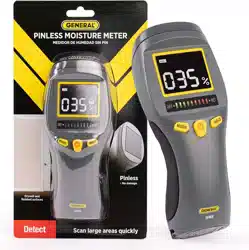Loading ...
Loading ...
Loading ...

SETUP INSTRUCTIONS
INSTALL BATTERY
Open the battery compartment at the bottom of the meter (Fig. 1, Callout F) and
plug the included “9V” battery into the wired socket inside the compartment.
The terminals of the battery and the socket mate in only one way, with the
smaller male terminal plugging into the larger female terminal. Close the
compartment after installing the battery.
OPERATING INSTRUCTIONS
To power on the meter, press and hold the
button (Fig. 1, Callout E)
for at
least three seconds. (To power off the meter, follow the same instruction.)
To measure the moisture level of drywall, masonry, hardwood or
softwood, press the MODE button until the name of the target material
appears on the LCD (WALL is short for drywall). Then scan the material by
gently pressing the inductive sensing area (Fig. 1, Callout G) on the top of the
meter against the material. The LCD will display the material’s moisture content
as a percentage.
Simultaneously, one or more bar graph LEDs will illuminate to place the
material’s moisture level within a spectrum bounded by “dry” and “wet”. The
color of the illuminated LED furthest to the right indicates which % band
contains the material (see the Specifications section on p. 7 for the bands’
boundaries).
To hold a reading, press the HOLD button briefly. The display will show the
held value, along with a lock icon above the % sign. If the reading is above the
alarm limit for that material, pressing the HOLD button will silence the alarm.
MEASUREMENT TIPS
For maximum accuracy, press the sensing area against a flat area of a
representative sample of the target material. The sample’s length and width
should be at least as large as the dimensions of the inductive sensing area:
1.6 x 1.6 in. (40 x 40mm).
Ideally, the material should also be at least 3/4 in. thick. That is the meter’s
maximum measurement depth and the thickness it is calibrated for. If your
sample is too thin, the meter will measure material beneath it as well and
produce an inaccurate reading. One way to compensate for thin samples is to
stack them.
6
Loading ...
Loading ...
